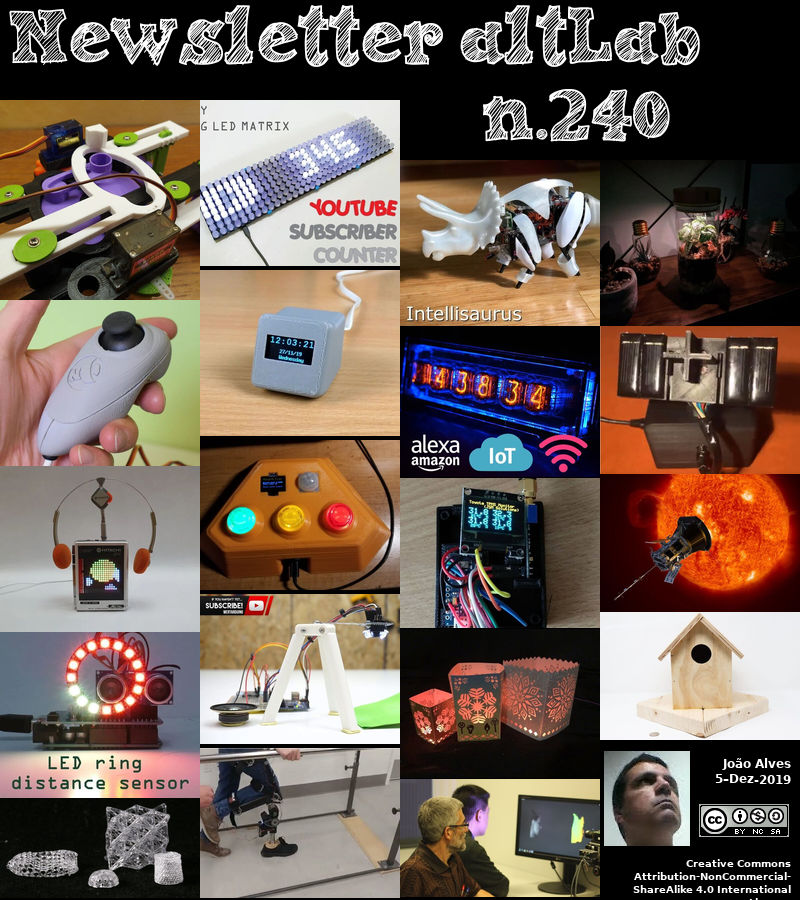2019-12-05 - Nº 240
Editorial
Esta é a Newsletter Nº 240 que se apresenta com o mesmo formato que as anteriores. Se gostar da Newsletter partilhe-a!
Todas as Newsletters encontram-se indexadas no link.
Esta Newsletter tem os seguintes tópicos:
Faz hoje anos que nascia, em 1868, Arnold Sommerfeld. Este físico alemão criou um modelo atómico que permitia explicar as linhas espectrais de estrutura fina. O seu primeiro trabalho foi sobre a teoria do giroscópio (com Klein) e, depois, sobre a propagação de ondas na telegrafia sem fio. Mais significativa foi a sua maior contribuição ao desenvolvimento da teoria quântica, em geral, e na sua aplicação a linhas espectrais e ao modelo atómico de Bohr. Ele desenvolveu também uma teoria do electrão no estado metálico, valiosa para o estudo da termoelectricidade.
Faz também anos hoje que nascia, em 1879, Clyde Vernon Cessna. Este piloto norte-americano, fabricante de aeronaves ficou conhecido por ter inventado a asa cantilever e uma configuração de cauda em forma de V assim como um desenho simples e flexível de monoplano. Ele é mais conhecido como o principal fundador da Cessna Aircraft Corporation.
Faz igualmente anos hoje que nascia, em 1901, Werner Heisenberg. Este físico e filósofo alemão descobriu uma maneira de formular a mecânica quântica em termos de matrizes (1925). Por esta descoberta, recebeu o Prémio Nobel de Física em 1932. Em 1927, publicou o seu princípio de indeterminação ou incerteza, sobre o qual construiu a sua filosofia e pelo qual é mais conhecido. Ele também fez importantes contribuições às teorias da hidrodinâmica da turbulência, do núcleo atómico, do ferromagnetismo, dos raios cósmicos e das partículas elementares, e planeou o primeiro reactor nuclear alemão pós-Segunda Guerra Mundial, em Karlsruhe, na Alemanha Ocidental.
Faz também anos hoje que nascia, em 1903, C. F. Powell. Este Físico inglês recebeu o Prémio Nobel de Física em 1950 pelo seu desenvolvimento do método fotográfico de estudo de processos nucleares e pela descoberta resultante do pião (pi-meson), uma partícula subatómica pesada. O pião provou ser a partícula hipotética proposta em 1935 por Yukawa Hideki do Japão na sua teoria.
Por fim, faz anos hoje que nascia, em 1932, Sheldon Lee Glashow. Este Físico teórico americano, com Steven Weinberg e Abdus Salam, recebeu o Prémio Nobel de Física em 1979 pelos seus esforços complementares na formulação da teoria eletrofraca, que explica a unidade do electromagnetismo e da força fraca.
Nesta semana que passou a NASA apresentou os primeiros resultados da sonda Parker que foi lançada para estudar o Sol. A sonda está resistindo a temperaturas escaldantes para recolher dados, que estão a ser apresentados pela primeira vez em quatro artigos que evidenciam características previamente desconhecidas e apenas teorizadas sobre o nosso volátil vizinho celeste. Durante os seus voos iniciais, a Parker estudou o Sol a uma distância de cerca de 24 milhões de quilómetros. Esta distância é mais próxima do Sol do que Mercúrio, mas a sonda ainda se aproximará ainda mais no futuro, pois viaja a mais de 213.000 km/h, mais rápido do que qualquer outra nave anterior. A informação que a Parker descobriu sobre como o Sol ejecta constantemente material e energia ajudarão os cientistas a reescrever os modelos que eles usam para entender e prever o clima espacial ao redor do nosso planeta, além de entender o processo pelo qual as estrelas são criadas e evoluem. Estas informações serão vitais para proteger os astronautas e a tecnologia no espaço - uma parte importante do programa Artemis da NASA, que enviará a primeira mulher e o próximo homem para a Lua em 2024 e, eventualmente, para Marte.
Na Newsletter desta semana apresentamos diversos projetos de maker. É apresentada a revista MagPi nº88 de Dezembro e também os livros "Raspberry PI Projects Book Volume 5" e "Book of Making Volume 2".
 João Alves ([email protected])
João Alves ([email protected])
O conteúdo da Newsletter encontra-se sob a licença  Creative Commons Attribution-NonCommercial-ShareAlike 4.0 International License.
Creative Commons Attribution-NonCommercial-ShareAlike 4.0 International License.
Novidades da Semana

First NASA Parker Solar Probe Results Reveal Surprising Details About Our Sun
"The Sun is revealing itself in dramatic detail and shedding light on how other stars may form and behave throughout the universe – all thanks to NASA's Parker Solar Probe. The spacecraft is enduring scorching temperatures to gather data, which are being shared for the first time in four new papers that illuminate previously unknown and only-theorized characteristics of our volatile celestial neighbor. The information Parker has uncovered about how the Sun constantly ejects material and energy will help scientists rewrite the models they use to understand and predict the space weather around our planet, and understand the process by which stars are created and evolve. This information will be vital to protecting astronauts and technology in space – an important part of NASA’s Artemis program, which will send the first woman and the next man to the Moon by 2024 and, eventually, on to Mars. The four papers, now available online from the journal Nature, describe Parker’s unprecedented near-Sun observations through two record-breaking close flybys. They reveal new insights into the processes that drive the solar wind – the constant outflow of hot, ionized gas that streams outward from the Sun and fills up the solar system – and how the solar wind couples with solar rotation." [...]
Outras Notícias
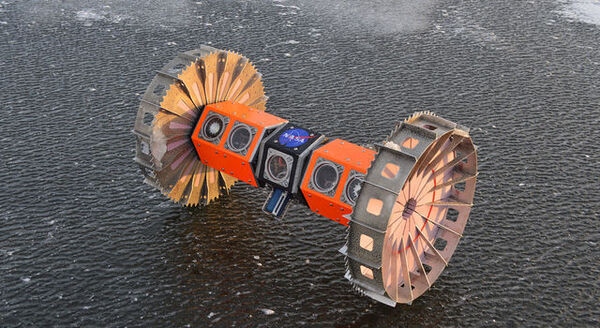
Aquatic Rover Goes for a Drive Under the Ice
"A little robotic explorer will be rolling into Antarctica this month to perform a gymnastic feat - driving upside down under sea ice. BRUIE, or the Buoyant Rover for Under-Ice Exploration, is being developed for underwater exploration in extraterrestrial, icy waters by engineers at NASA's Jet Propulsion Laboratory in Pasadena, California. It will spend the next month testing its endurance at Australia's Casey research station in Antarctica, in preparation for a mission that could one day search for life in ocean worlds beyond Earth. There are moons throughout the solar system believed to be covered in deep oceans hidden beneath thick, frozen surfaces. Scientists like Kevin Hand, JPL lead scientist on the BRUIE project, believe that these lunar oceans, such as those on Jupiter's moon Europa and Saturn's moon Enceladus, may be the best places to look for life in our solar system. But first, they'll need a tough aquatic explorer capable of navigating solo through an alien ocean locked under ice sheets that could be 6 to 12 miles (10 to 19 kilometers) thick." [...]
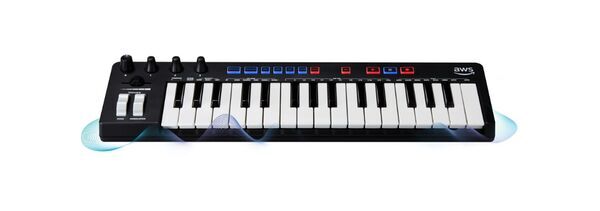
AWS DeepComposer Enables Developers to Get Hands-On with Generative AI
"At the kickoff for AWS re:Invent, Dr. Matt Wood, vice president of artificial intelligence (AI) at Amazon Web Services, announced AWS DeepComposer, the world’s first machine learning-enabled keyboard for developers to get hands-on with generative AI. Generative AI is one of the most fascinating advancements in AI technology because of its ability to create something new: from turning sketches into images for accelerated product development to improving computer-aided design of complex objects. AWS DeepComposer runs on Amazon EC2 C5 instances in the AWS cloud, which are powered by Intel® Xeon® Scalable processors. This builds on previous announcements that demonstrate the joint commitment of Intel and AWS to make hands-on machine learning education more accessible to developers: AWS DeepLens at re:Invent 2017 and AWS DeepRacer at re:Invent 2018. " [...]

Qualcomm Introduces the World’s Most Advanced 5G Mobile Platform
"The Qualcomm Snapdragon 865 5G Mobile Platform Delivers the Best 5G Mobile Experiences for Next Generation Flagship Devices - Devices Expected to be Commercially Available in First Quarter 2020 Qualcomm Technologies, Inc., a subsidiary of Qualcomm Incorporated, introduced the Qualcomm® Snapdragon™ 865 5G Mobile Platform, which combines the world’s most advanced 5G Modem-RF System with the world’s most advanced mobile platform designed to deliver the unmatched connectivity and performance required for the next generation of flagship devices. The platform’s best-in-class Qualcomm® Snapdragon™ X55 5G Modem-RF System provides peak speeds of up to 7.5 Gbps, surpassing most wired connections and transforming the mobile experience. The leading 5th generation Qualcomm® AI Engine and new Qualcomm® Sensing Hub provides more intelligence and personalization than ever before. Snapdragon 865 includes the blazing fast Qualcomm Spectra™ 480 Image Signal Processor (ISP), which brings new features to mobile photography and videography thanks to gigapixel speeds – up to 2 gigapixels per second. Gamers can use Snapdragon to compete at the highest levels with an array of brand-new Qualcomm® Snapdragon Elite Gaming™ features for desktop-quality gaming and ultra-realistic graphics. Our next generation Qualcomm® Kryo™ 585 CPU delivers up to 25% performance improvement, and the new Qualcomm® Adreno™ 650 GPU offers up to 25% overall performance boost compared to the previous generations[1], ensuring superior processing power for the next generation of flagship devices." [...]

SpaceX Dragon Heads to Space Station with NASA Science, Cargo
"A SpaceX Dragon cargo spacecraft is on its way to the International Space Station after launching at 12:29 p.m. EST Thursday. Dragon will deliver more than 5,700 pounds of NASA cargo and science investigations, including studies of malting barley in microgravity, the spread of fire, and bone and muscle loss. The spacecraft launched on a Falcon 9 rocket from Space Launch Complex 40 at Cape Canaveral Air Force Station in Florida and is scheduled to arrive at the orbital outpost on Sunday, Dec. 8. Coverage of the spacecraft’s approach and arrival at the space station will begin at 4:30 a.m. on NASA Television and the agency’s website. Dragon will join three other spacecraft currently at the station. Expedition 61 Commander Luca Parmitano of ESA (European Space Agency) will grapple Dragon with NASA astronaut Andrew Morgan acting as a backup." [...]
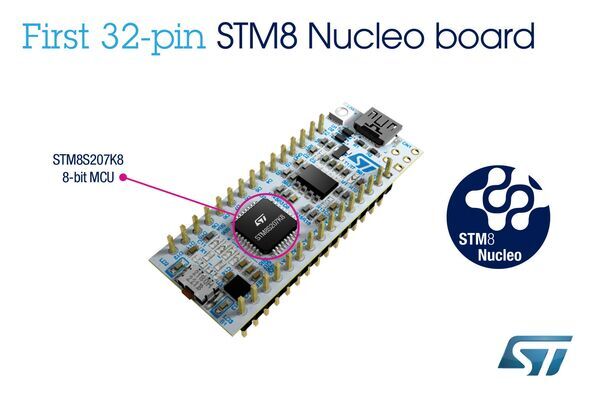
STMicroelectronics Launches Affordable and Easy-to-Use STM8 Nucleo-32 Boards
"STMicroelectronics is making design starts using 8-bit STM8 microcontrollers (MCUs) faster, more affordable, and more accessible for creative minds of all types by introducing new development boards in the easy-to-use Nucleo-32 form factor . The compact boards are controlled and powered conveniently through a USB connection. An ST-LINK debugger/programmer is integrated, which saves using an external debug probe and allows simple drag-and-drop Flash programming. Arduino™ Nano pins simplify functional expansion using off-the-shelf shields and let users connect with open-source hardware communities. The boards are supported by major development toolchains including IAR Embedded Workbench for STM8 and Cosmic CXSTM8. STM8 MCUs feature a high-performing 8-bit core, generous on-chip memory including up to 128Kbyte of Flash, and state-of-the-art peripherals shared with the STM32 MCU family such as timers, analog peripherals, CAN2.0B, and digital interfaces." [...]
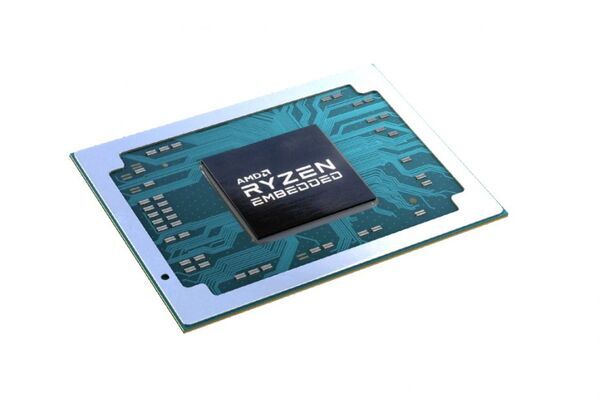
AMD Enables Ecosystem for High-Performance Mini PCs Powered by AMD Ryzen™ Embedded Processors
"AMD today announced it is enabling an open ecosystem for OEMs to create and customize high performance Mini PCs, powered by AMD Ryzen™ Embedded V1000 and R1000 processors. ASRock Industrial, EEPD, OnLogic and Simply NUC, are the first OEMs to offer and sell these new Mini PC platforms for the industrial, media, communications and enterprise markets. These companies are giving customers an open and customizable platform based on high-performance CPU/GPU processor with expansive peripheral support, in-depth security features and a planned 10-year processor availability. “The demand for high performance computing isn’t limited to servers or desktop PCs. Embedded customers want access to small form factor PCs that can support open software standards, demanding workloads at the edge, and even display 4K content, all with embedded processors that have a planned availability of 10 years,” said Rajneesh Gaur, corporate vice president and general manager, Embedded Solutions, AMD. “This is why many of our technology partners have chosen AMD Ryzen Embedded processors to power their Mini PCs." [...]

AI-Powered Astronaut Assistant Returns to Space with “Emotional Intelligence”
"CIMON, the world’s first AI-powered astronaut assistant, returned to the International Space Station—this time with a heightened ability to analyze human emotion. The objective, according to the researchers who fine-tuned the robot after its first successful mission aboard the spacecraft, is to transform CIMON from a scientific assistant into “an empathetic companion.” As was the original CIMON, which spent 14 months in space, the new and improved CIMON-2 is a joint project by IBM, Airbus and the German Aerospace Center (DLR). CIMON-1 returned to Earth from the International Space Station (ISS) in August. CIMON-2 is heading back to the space station on a SpaceX rocket that launched Dec. 4 from Kennedy Space Center in Cape Canaveral, Florida. CIMON, which stands for Crew Interactive Mobile Companion, was developed to help astronauts with their many tasks and research activities. The voice-controlled floating robot, which operates with a slight smile on its screen face, can display instructions and record images during an experiment." [...]
Ciência e Tecnologia
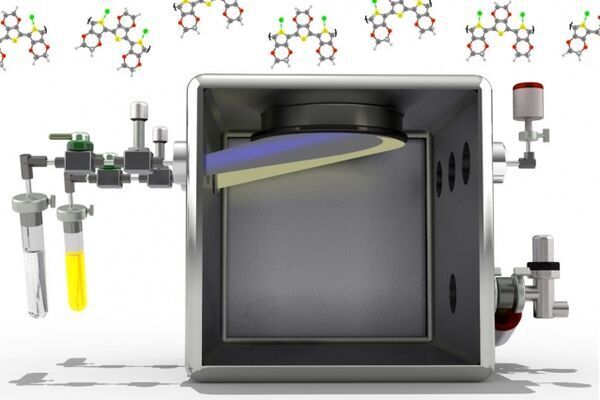
Clear, conductive coating could protect advanced solar cells, touch screens
"New material should be relatively easy to produce at an industrial scale, researchers say. MIT researchers have improved on a transparent, conductive coating material, producing a tenfold gain in its electrical conductivity. When incorporated into a type of high-efficiency solar cell, the material increased the cell’s efficiency and stability. The new findings are reported today in the journal Science Advances, in a paper by MIT postdoc Meysam Heydari Gharahcheshmeh, professors Karen Gleason and Jing Kong, and three others. “The goal is to find a material that is electrically conductive as well as transparent,” Gleason explains, which would be “useful in a range of applications, including touch screens and solar cells.” The material most widely used today for such purposes is known as ITO, for indium titanium oxide, but that material is quite brittle and can crack after a period of use, she says. Gleason and her co-researchers improved a flexible version of a transparent, conductive material two years ago and published their findings, but this material still fell well short of matching ITO’s combination of high optical transparency and electrical conductivity." [...]

Big Plans to Save the Planet Depend on Nanoscopic Materials Improving Energy Storage
"The challenge of building an energy future that preserves and improves the planet is a massive undertaking. But it all hinges on the charged particles moving through invisibly small materials. Scientists and politicians have recognized the need for an urgent and sizable shift in the world’s mechanisms of energy production and consumption in order to arrest its momentum toward environmental cataclysm. A course correction of this magnitude is certainly daunting, but a new report in the journal Science suggests that the technological path to achieving sustainability has already been paved, it’s just a matter of choosing to follow it. The report, authored by an international team of researchers, lays out how research in the field of nanomaterials for energy storage over the last two decades has enabled the big step that will be necessary to make use of sustainable energy sources. “Most of the biggest problems facing the push for sustainability can all be tied back to the need for better energy storage,” said Yury Gogotsi, PhD, Distinguished University and Bach professor at Drexel University’s College of Engineering and lead author of the paper." [...]
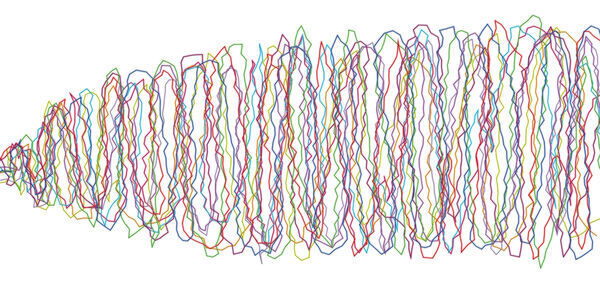
Theorists probe the relationship between ‘strange metals’ and high-temperature superconductors
"Strange metals make interesting bedfellows for a phenomenon known as high-temperature superconductivity, which allows materials to carry electricity with zero loss. Both are rule-breakers. Strange metals don’t behave like regular metals, whose electrons act independently; instead their electrons behave in some unusual collective manner. For their part, high-temperature superconductors operate at much higher temperatures than conventional superconductors; how they do this is still unknown. In many high-temperature superconductors, changing the temperature or the number of free-flowing electrons in the material can flip it from a superconducting state to a strange metal state or vice versa. Scientists are trying to find out how these states are related, part of a 30-year quest to understand how high-temperature superconductors work so they can be developed for a host of potential applications, from maglev trains to perfectly efficient power transmission lines." [...]
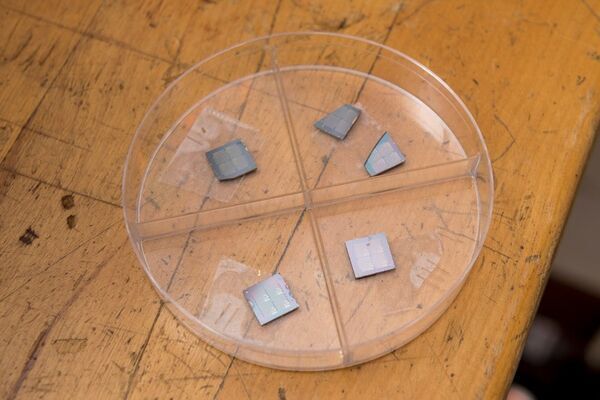
A Record-setting Transistor
"Engineering professor designs transistor that could enable cheaper, faster wireless communications Many of the technologies we rely on, from smartphones to wearable devices and more, utilize fast wireless communications. What might we accomplish if those devices transmitted information even faster? That’s what Yuping Zeng, assistant professor of electrical and computer engineering at the University of Delaware, aims to discover. She and a team of researchers recently created a high-electron mobility transistor, a device that amplifies and controls electrical current, using gallium nitride (GaN) with indium aluminum-nitride as the barrier on a silicon substrate. They described their results in the journal Applied Physics Express. Among devices of its type, Zeng’s transistor has record-setting properties, including record low gate leakage current (a measure of current loss), a record high on/off current ratio (the magnitude of the difference of current transmitted between the on state and off state) and a record high current gain cutoff frequency (an indication of how much data can be transmitted with a wide range of frequencies)." [...]
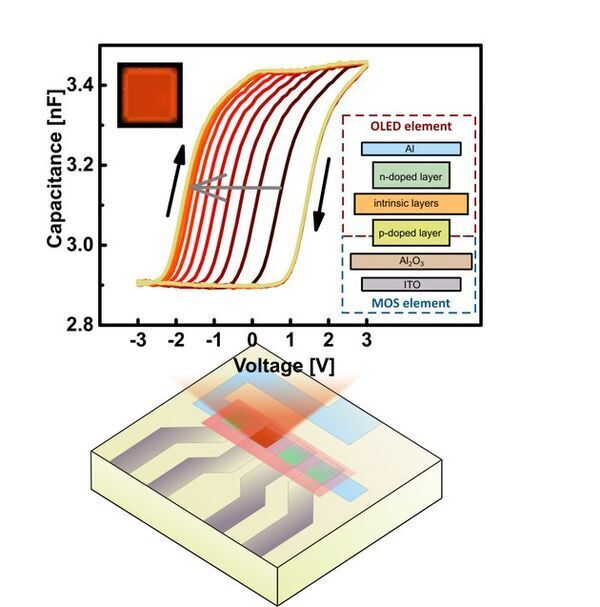
PinMOS: Novel Memory Device Combining Oled And Insulator Can Be Written On And Read Out Optically Or Electrically
"Scientists of the Dresden Integrated Center for Applied Physics and Photonic Materials (IAPP) and the Center for Advancing Electronics Dresden (cfaed) at TU Dresden have developed a novel storage technology based on the combination of an organic light-emitting diode (OLED) and an insulator. This device allows reading the stored information optically as well as electrically. Moreover, the information can be added in portions - thus several storage states can be mapped in one device. The results have now been published in the renowned journal "Advanced Functional Materials". Another novelty was related to the measurements in the test series: They were carried out exclusively using the innovative "SweepMe!” measuring software, which was developed by an IAPP / cfaed start-up of the same name. This story began a few way back in 2015." [...]
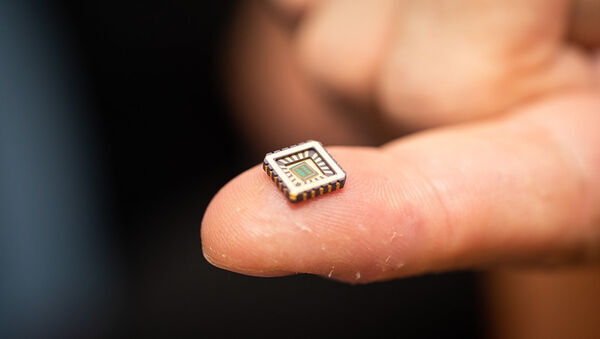
World first as artificial neurons developed to cure chronic diseases
"Artificial neurons on silicon chips that behave just like the real thing have been invented by scientists – a first-of-its-kind achievement with enormous scope for medical devices to cure chronic diseases, such as heart failure, Alzheimer's, and other diseases of neuronal degeneration. Critically the artificial neurons not only behave just like biological neurons but only need one billionth the power of a microprocessor, making them ideally suited for use in medical implants and other bio-electronic devices. The research team, led by the University of Bath and including researchers from the Universities of Bristol, Zurich and Auckland, describe the artificial neurons in a study published in Nature Communications. Designing artificial neurons that respond to electrical signals from the nervous system like real neurons has been a major goal in medicine for decades, as it opens up the possibility of curing conditions where neurons are not working properly, have has their processes severed as in spinal cord injury, or have died. Artificial neurons could repair diseased bio-circuits by replicating their healthy function and responding adequately to biological feedback to restore bodily function. In heart failure for example, neurons in the base of the brain do not respond properly to nervous system feedback, they in turn do not send the right signals to the heart, which then does not pump as hard as it should." [...]

SLAC scientists invent a way to see attosecond electron motions with an X-ray laser
"Called XLEAP, the new method will provide sharp views of electrons in chemical processes that take place in billionths of a billionth of a second and drive crucial aspects of life. Researchers at the Department of Energy’s SLAC National Accelerator Laboratory have invented a way to observe the movements of electrons with powerful X-ray laser bursts just 280 attoseconds, or billionths of a billionth of a second, long. The technology, called X-ray laser-enhanced attosecond pulse generation (XLEAP), is a big advance that scientists have been working toward for years, and it paves the way for breakthrough studies of how electrons speeding around molecules initiate crucial processes in biology, chemistry, materials science and more. The team presented their method today in an article in Nature Photonics. “Until now, we could precisely observe the motions of atomic nuclei, but the much faster electron motions that actually drive chemical reactions were blurred out,” said SLAC scientist James Cryan, one of the paper’s lead authors and an investigator with the Stanford PULSE Institute, a joint institute of SLAC and Stanford University. “With this advance, we’ll be able to use an X-ray laser to see how electrons move around and how that sets the stage for the chemistry that follows." [...]
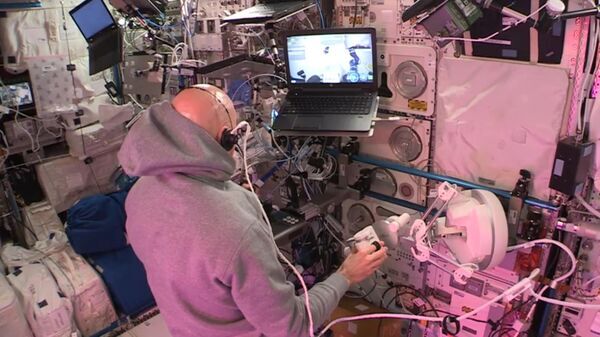
An EPFL robot in space
"The crew of the International Space Station has taken delivery of a haptic interface designed by EPFL spin-off Force Dimension. Astronauts could one day use the device, based on the famous delta robot developed at EPFL by Reymond Clavel, to control unmanned Martian and lunar rovers from afar. In a project called METERON, the European Space Agency (ESA) is exploring how advanced robots could be used to repair satellites in orbit or probe hostile environments like the Martian and lunar surfaces. The plan is for astronauts to control the robots remotely from the International Space Station (ISS), using a haptic interface that allows them to “feel” their every move. For this project, the ESA has opted for an interface based on the famous delta robot, designed 34 years ago by Reymond Clavel at EPFL’s School of Engineering. The new device, developed by Force Dimension – a spin-off of EPFL’s VRAI Group, led by Charles Baur – reached the ISS earlier this month." [...]
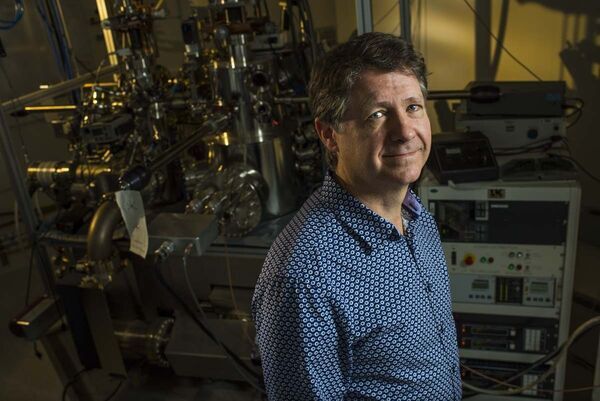
Molecular eraser enables better data storage and computers for AI
"Scientists have added a crucial tool to the atomic-scale manufacturing toolkit with major implications for today’s data driven—carbon intensive—world, according to new research from the University of Alberta in Canada. “Computers today are contributing one gigatonne of carbon emissions to the atmosphere, and we can eliminate that by enhancing the most power-hungry parts of conventional computers with our atomic-scale circuitry,” said Robert Wolkow, professor in the University of Alberta’s Department of Physics, a Principal Research Officer at the National Research Council of Canada’s Nanotechnology Research Centre, and chief technical officer of Quantum Silicon Inc, a spinoff company taking the technology to market. “This new tool better enables an ultra-efficient kind of hybrid computer for the training of neural networks for artificial intelligence.” The latest finding speeds up the atomic-scale manufacturing process, taking advantage of a natural physical phenomenon. Hydrogen molecules seek out and automatically repair errors in atomic-scale circuitry and can be used to significantly improve the rewriting speeds of atomic data storage. This work builds on the decades-long dedication by Wolkow’s research group to realizing the potential for atomic-scale manufacturing, something that has shifted from an idealistic dream to an ever more likely reality in the next few years. “It will take a couple of years, but there’s an actual path to atomic-scale devices that will be very impactful for our world,” said Roshan Achal, lead author on the new discovery, currently completing his PhD with Wolkow." [...]
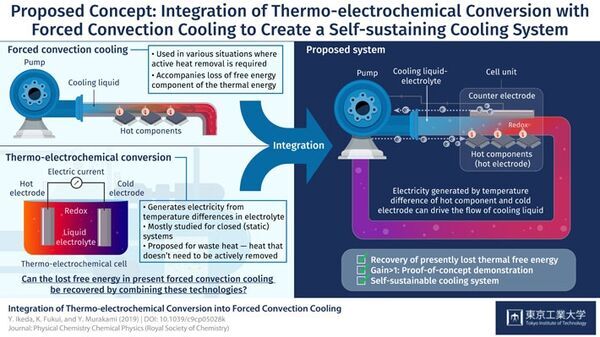
Thermo-chemical power generation integrated with forced convection cooling to create a self-sustaining liquid cooling system
"Scientists at Tokyo Institute of Technology (Tokyo Tech) combine forced convection cooling with thermo-electrochemical energy conversion to create a self-sustaining liquid cooling system. A liquid electrolyte is circulated through a cell to cool a hot object, and the reversible chemical reaction in the cell generates a higher electric power than the hydrodynamic pump work required to drive the liquid through the cell. This technology resolves the longstanding unaddressed issue of the loss of free energy component of the thermal energy that accompanies forced convection cooling, a process that has widespread use in the modern world. Active cooling is crucial in most modern technologies, ranging from microprocessors in data centers to turbines and engines. Forced convection cooling, which circulates a coolant fluid over the surface of a hot object, is effective for meeting such cooling requirements but demands a pumping power to send the coolant through the heat generating section. However, active cooling — fast removal of a large quantity of thermal energy in the heat source under a large temperature difference — promptly destroys the free-energy component of the thermal energy, which is an energy portion that can be converted to an electric work." [...]
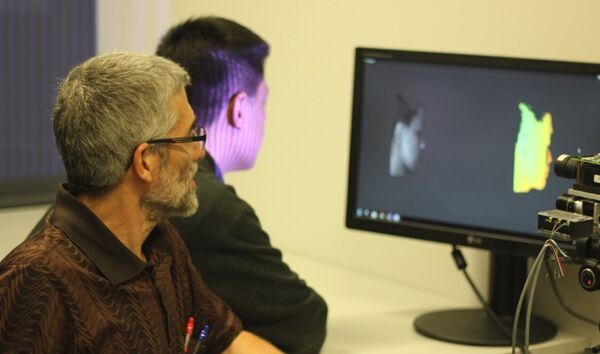
3D scanner could increase accuracy of surgery
"Researchers have created a new scanner that can improve everything from surgical procedures to our understanding of landslides. The new scanning technology, created by engineering researchers at the University of Waterloo, is able to capture full-field 3D surface-shape data in real time by enabling 3D capabilities at every camera pixel. The high-resolution technology uses novel algorithms to compute surface shape at the same frame rate as video with a measurement accuracy of approximately 0.1 mm and can capture images of moving or static objects. “We’ve been able to measure the shape of a surface in real-time, whether it’s a rigid or a deforming surface,” said Jonathan Kofman, director of the University’s Intelligent Human-Machine Systems and 3D Imaging Laboratories. The scanner, described by Kofman as a 3D video camera, can be mounted on a tripod or robot, or be hand-held. Used during surgery, it can take real-time measurements of an organ or tissues that may have shifted or changed shape since images were taken before the operation began." [...]

New device enables battery-free computer input at the tip of your finger
"Computer scientists at the University of Waterloo have created a device for wearable computer input suitable for many situations, just by touching your fingertips together in different ways. The device, called Tip-Tap, is inexpensive and battery-free through the use of radio frequency identification (RFID) tags to sense when fingertips touch. The device could, therefore, be added to disposable surgical gloves, allowing surgeons to access preoperative planning diagrams in an operating room. “One of the many possible applications of the device is in surgeries. What typically happens now with operation digital preplanning is that an assistant is responsible for navigating the computer and communicating with the surgeon, but this is slow and difficult", said Daniel Vogel, a professor in Waterloo’s David R. Cheriton School of Computer Science. “If the surgeon tries to navigate it themselves using a touchscreen or a mouse, it’s problematic because it would require constant sterilization, and current alternatives such as big gestures tracked by computer vision can get very tiring." [...]
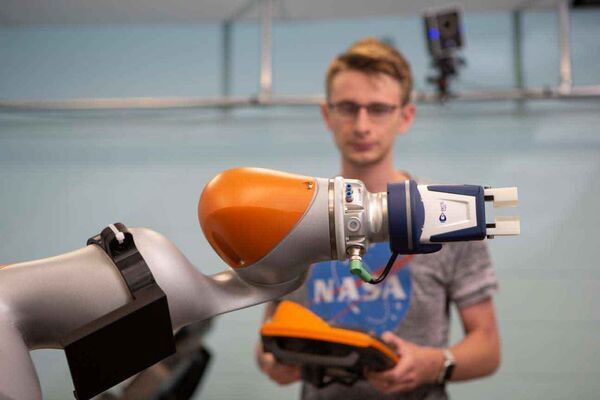
UC develops satellites that fix other satellites
"For his latest study, professor Ou Ma engineered robots to work independently but collaboratively When satellites break, which is surprisingly often, there isn’t much you can do about them. They become expensive and dangerous flotsam, orbiting Earth for years or generations until gravity eventually draws them to a fiery death in the atmosphere. University of Cincinnati professor Ou Ma is engineering robotics technology to fix orbiting satellites in his Intelligent Robotics and Autonomous Systems Lab. He envisions robotic satellites that can dock with other satellites for repairs or refueling. The project demonstrates UC's commitment to research as described in its strategic direction, Next Lives Here. Ma said a million things can go wrong with every satellite launch." [...]

Energy hubs in the North Sea require new digital solutions
"Energy hubs in the North Sea, that can collect and distribute energy from offshore wind farms to the European countries, are challenging the usual way of designing electricity grids. A project led by Technical University of Denmark is now developing new solutions. An international consortium, called the North Sea Wind Power Hub, is currently investigating how to optimize and utilize wind energy from the North Sea. The potential for wind energy in the North Sea is up to 180 GW. "This is equivalent to replacing all coal-fired power plants in Europe with wind energy from the North Sea," says Jacob Østergaard, Professor and Head of Center for Electric Power and Energy at DTU Elektro. In order to be able to harvest the many sustainable gigawatts from the stormy sea between the Netherlands, Germany, the UK, Denmark and Norway, the vision is to increase the number of offshore wind turbines connecting to so-called energy hubs, for example in the form of an artificial island." [...]

UV Satellite Will Open New View on Exploding Stars and Black Holes
"DESY to build 100-megapixel camera for Israeli space telescope A new space telescope will open up an unprecedented view of the universe in ultraviolet light: The ULTRASAT satellite will provide fundamental new insights into high-energy phenomena such as supernova explosions, colliding neutron stars and active black holes, all of which can also generate gravitational waves and act as cosmic particle accelerators. On Monday in Rehovot, Israel, the President of the Helmholtz Association, Otmar D. Wiestler, and the Director of the Helmholtz centre DESY, Helmut Dosch, agreed with the Weizmann Institute of Science on a cooperation for German participation in the Israeli-led project. DESY will build the 100-megapixel UV camera for the space telescope. For the project, DESY is working with the German Aerospace Center DLR, which also is a member of the Helmholtz Association. “Helmholtz has had many excellent scientific collaborations with Israeli partners for decades. Together with the Weizmann Institute of Science, we are now taking another important step in the field of astrophysics." [...]

‘Electronic skin for haptic interfaces’ – light, tight and battery-free
"A system of “electronic skin-integrated haptic interfaces” jointly developed by City University of Hong Kong (CityU) and other academic institutions can help users of prosthesis to feel the surrounding environment and be used for social media, entertainment and gaming. This novel system can transmit sensory stimuli to the body via the wireless actuator that converts energy to mechanical vibrations. It uses our skin as the sensory interface for virtual reality (VR) and augmented reality (AR). The research achievement has recently been published in Nature, a leading international journal, in an article titled “Skin-Integrated Wireless Haptic Interfaces for Virtual and Augmented Reality”. “Our target is to develop electronic skin that can be comparable to human skin,” said Dr Yu Xinge, the principal author of the article and Assistant Professor at CityU’s Department of Biomedical Engineering. “Compared with similar types of equipment on the market, our new system is light and thin that can be tightly attached to human skin." [...]

Carpentry Compiler helps woodworkers design objects that they can actually make
"As the holidays approach, people might be thinking of neat do-it-yourself woodworking projects to give as gifts. But there’s often a disconnect between designing an object and coming up with the best way to make it. Now researchers at the University of Washington have created Carpentry Compiler, a digital tool that allows users to design woodworking projects. Once a project is designed, the tool creates optimized fabrication instructions based on the materials and equipment a user has available. The team presented this research Nov. 19 at SIGGRAPH Asia in Brisbane, Australia. “To make a good design, you need to think about how it will be made,” said senior author Adriana Schulz, an assistant professor in the Paul G. Allen School of Computer Science & Engineering." [...]
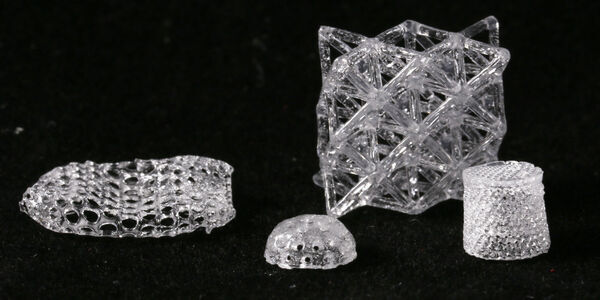
Glass from a 3D printer
"ETH researchers used a 3D printing process to produce complex and highly porous glass objects. The basis for this is a special resin that can be cured with UV light. Producing glass objects using 3D printing is not easy. Only a few groups of researchers around the world have attempted to produce glass using additive methods. Some have made objects by printing molten glass, but the disadvantage is that this requires extremely high temperatures and heat-resistant equipment. Others have used powdered ceramic particles that can be printed at room temperature and then sintered later to create glass; however, objects produced in this way are not very complex." [...]

Atomic-scale manufacturing method could enable ultra-efficient computers
"“Detecting and Directing Single Molecule Binding Events on H-Si(100) with Application to Ultradense Data Storage” ACS Nano As computers continue to infiltrate almost every aspect of modern life, their negative impact on the environment grows. According to recent estimates, the electricity required to power today’s computers releases a total of more than 1 gigatonne of carbon emissions to the atmosphere each year. Now, researchers reporting in ACS Nano have developed a new manufacturing process that could enable ultra-efficient atomic computers that store more data and consume 100 times less power. Scientists have previously manipulated single atoms to make ultra-dense memory arrays for computers, which store more data in a much smaller space than conventional hard drives and consume much less power. In a technique known as hydrogen lithography, researchers use the tip of a scanning tunneling microscope (STM) to remove single atoms of hydrogen bonded to a silicon surface. The pattern of silicon atoms bound to or lacking a hydrogen atom forms a binary code that stores the data." [...]

New Pads Absorb Shock Better Than Foam With Air Flow and Easy Manufacture
"HRL Laboratories’ Microlattice Impact Attenuator Pads Outperform Current Helmet Pads in Single or Multiple Hits and are Made with Light-Casting Technology HRL Laboratories, LLC, has published test results showing shock-absorbing pads made from HRL’s microlattice—an architected elastomeric material—had up to 27% more energy absorption efficiency than the current best-performing expanded polystyrene (EPS) foam when sustaining a single impact and up to 48% improved absorption efficiency over the state-of-the-art vinyl nitrile foam when impacted repeatedly. The microlattice material could replace currently used foams in applications such as protective packaging, shock isolators for electronics, vehicle interiors, and padding in football, military, or bicycle helmets. The paper entitled Elastomeric microlattice impact attenuators is the featured cover article in the journal Matter for December 2019. “The best competing architected pads to date have maximum energy absorption efficiencies up to 44% for a single impact,” said Eric Clough, HRL researcher and the paper’s lead author. “Our best performing microlattice pads had maximum energy absorption efficiencies of nearly 58%. Also, the competitor lattice-based pads are irreversibly smashed after sustaining a single impact." [...]
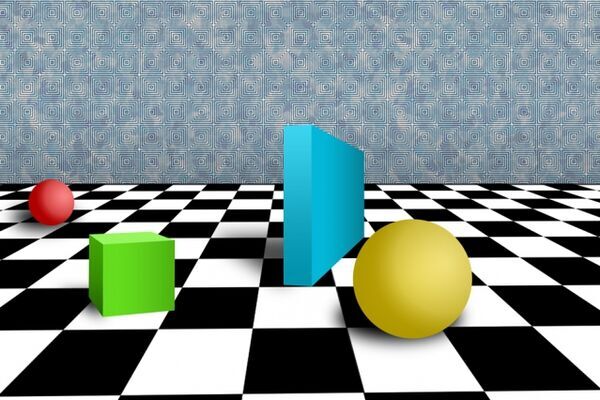
Helping machines perceive some laws of physics
"Model registers “surprise” when objects in a scene do something unexpected, which could be used to build smarter AI. Humans have an early understanding of the laws of physical reality. Infants, for instance, hold expectations for how objects should move and interact with each other, and will show surprise when they do something unexpected, such as disappearing in a sleight-of-hand magic trick. Now MIT researchers have designed a model that demonstrates an understanding of some basic “intuitive physics” about how objects should behave. The model could be used to help build smarter artificial intelligence and, in turn, provide information to help scientists understand infant cognition. The model, called ADEPT, observes objects moving around a scene and makes predictions about how the objects should behave, based on their underlying physics." [...]
Documentação
A documentação é parte essencial do processo de aprendizagem e a Internet além de artigos interessantes de explorar também tem alguma documentação em formato PDF interessante de ler. Todos os links aqui apresentados são para conteúdo disponibilizado livremente pelo editor do livro.
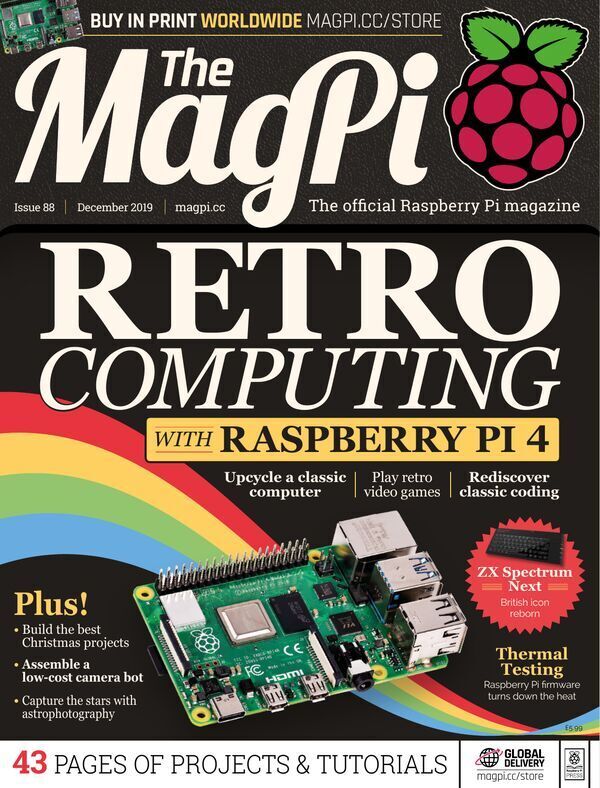
The MagPI 88
"Rediscover retro computing and thermal-testing the new firmware. All in the latest edition of The MagPi magazine. Plus! All this inside The MagPi magazine issue 88… Raspberry Pi 4 Retro Computing. Upcycle vintage computers with a super-fast Raspberry Pi 4; build your own DIY arcade console; and buy the best gaming kit. Everything you need to fall in love with classic computers all over again." [...]
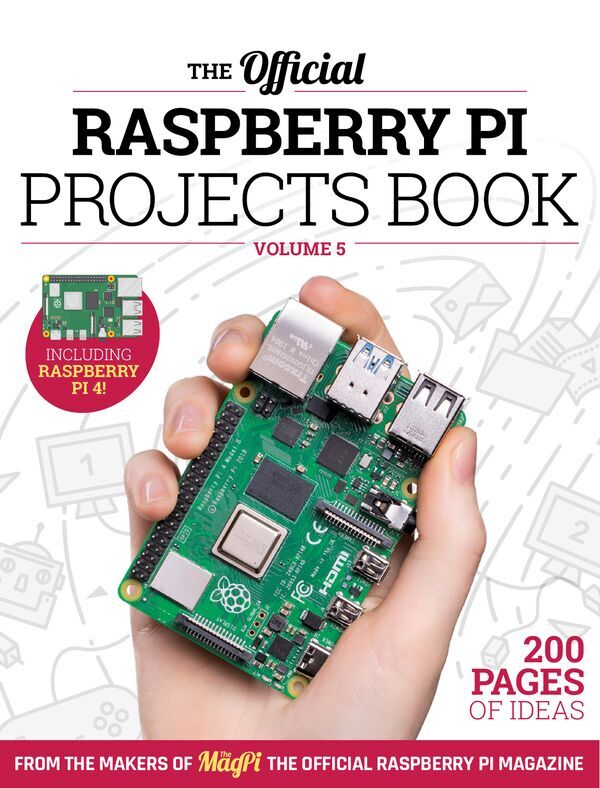
Raspberry PI Projects Book Volume 5
"The Raspberry Pi is loved the world over by educators and makers thanks to its tiny size and endless possibilities. Find out why it’s loved and how to use it with the latest official Projects Book - we’ve managed to stuff the fifth edition with another 200 pages of inspiring projects, practical tutorials, and definitive reviews. - Learn all about the latest model: Raspberry Pi 4* - Get involved with the amazing Raspberry Pi community - Be inspired by incredible projects made by other people - Learn how to make with your Raspberry Pi with our help - Find out about the top kits and accessories for your Pi projects - And much, much more! " [...]
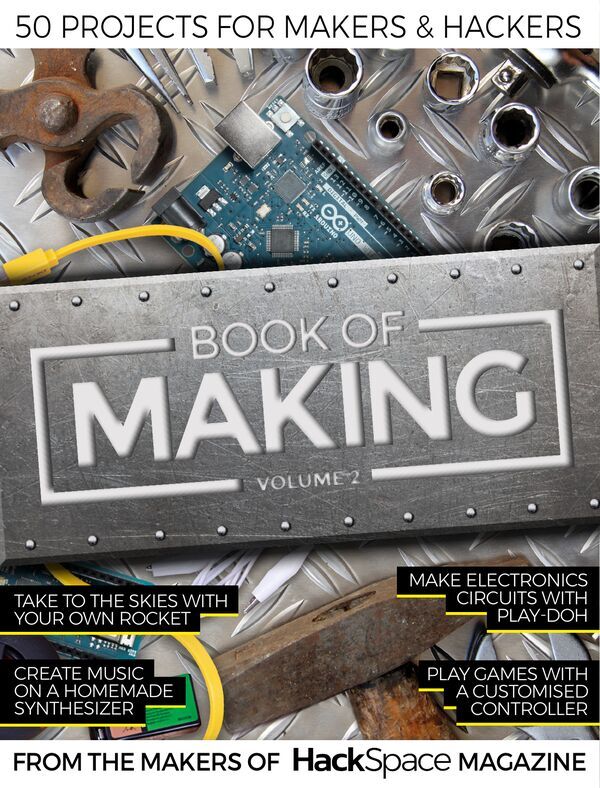
Book of Making Volume 2
"We’ve gathered up our favourite maker projects from the second year of HackSpace magazine in one place – the Book of Making volume two. It’s 180 pages of hands-on guides, tips, tricks, and inspiration. We show you how to build and launch your own rocket, create electronics circuits with Play-Doh, build your own polyphonic synthesizer, and much more. Whether you’ve got an hour to build something or you’re looking for a weekend project, we’ve got a range of maker projects to choose from. - Step into the wonderful world of making - Be inspired by amazing projects from makerspace communities around the world - Make your own creations with step-by-step guides - Perfect projects for an hour, an afternoon, or weekend" [...]
Projetos Maker
Diversos Projetos interessantes.
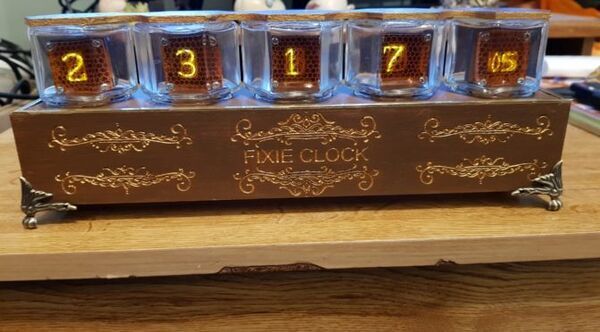
FIXIE CLOCK
"The Fake ‘Nixie’ clock So I had an idea about making fake nixie tubes with an OLED display and a laser etched filter. I had a play for Makevember and I was quite pleased with the outcome using a 128×64 bit white I2c OLED display. The first test was with a plain acrylic etched peice" [...]

Intellisaurus
"Intellisaurus is intended for many skill levels. The easy to follow instructions allow someone with a modest skill level to assemble the robot and have it walking in a matter of hours. There is no soldering or programming required to build and play with it. This fun loving guy reaches 8 inches tall. He sports an Arduino Nano to control the motors and a Raspberry Pi Zero W to connect to the internet and run Google Assistant, or other various AI algorithms.All open source software, so you are in control, modify, and improve your Intellisaurus. " [...]
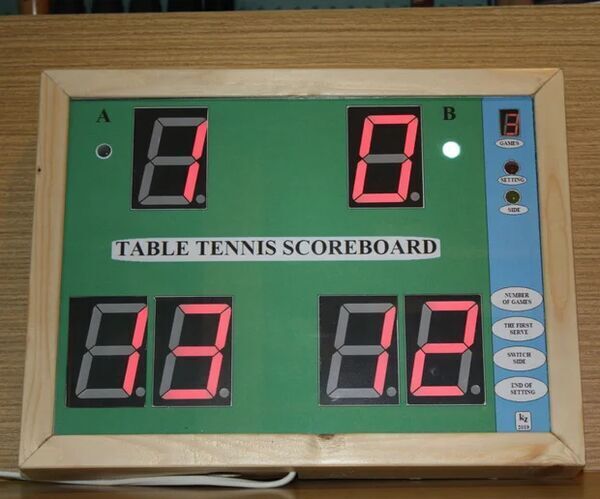
Bloetooth Table Tennis Scoreboard
"Introduction My new project, the Table Tennis Scoreboard is dedicated for amateur sport`s fans and table tennis players. The Scoreboard is amazing enhancement for Table Tennis at home. Especially children like to play the games only in order "push" touch buttons. But even for adults there is big contribution. If game is interrupted, score is memorized, or serve side is memorized. Futhermore, the mistake in score counting during match is eliminated." [...]

Power Efficient Motor Driver Board
"The project presented is a stepper motor/motor driver circuit board with SN755410 motor driver IC including some power saving features. The board can drive 2 DC motors or a stepper motor with the help of dual H bridge circuit in the IC. SN754410 IC is being widely used for driving motors as it operates in wide range of voltage and can drive up to 1A current per channel. The additional thing here is the power switching circuit which will cut off the power to IC, this can be very power efficient than normal sleep modes. It needs an external signal from controller to turn ON the power to the driver circuit. The switching circuit is built around a couple of NPN transistors and a P channel MOSFET which will let the power flow only when we apply pulse to the circuit." [...]
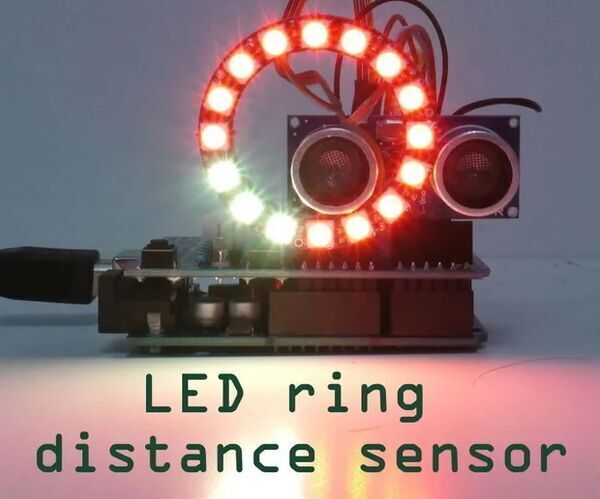
LED Ring Distance Sensor
"Hello there, this is The Developer Guy, and let me introduce You to this very short, but fun project, which will end up in an alternative parking sensor. Yes, you COULD write the measured distance on an LCD display. Yes, you CAN use a different distance sensor and YES, you can use different LED rings too. This project is about showing an alternative. (oh, and of course any Arduino compatible board is fine if it handles the FastLED lib) Supplies: - Arduino (I used Uno) - distance sensor (HC-SR04) - Neopixel ring" [...]

IR Remote Analyzer / Receiver With Arduino
"This analyzer receives 40 different IR protocols concurrently and shows the address and code of the received signal. If you want to analyze your remote or want to control your Arduino application with a spare remote, you need to know the code sent for each key. A serial or paralell LCD can be attached to operate this as a standalone device without the need of a Serial Monitor. " [...]
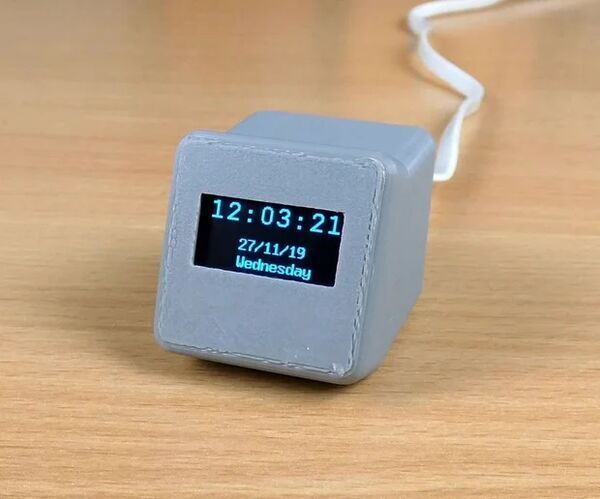
Network Time Digital Clock Using the ESP8266
"We learn how to build a cute little digital clock that communicates with NTP servers and displays network or internet time. We use the WeMos D1 mini to connect to a WiFi network, obtain the NTP time and display it on an OLED module. The video above talks you through the entire process of building this project. " [...]

GPS Location Finder
"Hi everyone , Today let us see how to make a NEO-6m GPS module and arduino.first let us see what is GPS . The Global Positioning System (GPS), originally NAVSTAR GPS, is a satellite-based radionavigation system owned by the United States government and operated by the United States Air Force. It is a global navigation satellite system (GNSS) that provides geolocation and time information to a GPS receiver anywhere on or near the Earth where there is an unobstructed line of sight to four or more GPS satellites. Obstacles such as mountains and buildings block the relatively weak GPS signals. The GPS does not require the user to transmit any data, and it operates independently of any telephonic or internet reception, though these technologies can enhance the usefulness of the GPS positioning information. The GPS provides critical positioning capabilities to military, civil, and commercial users around the world." [...]
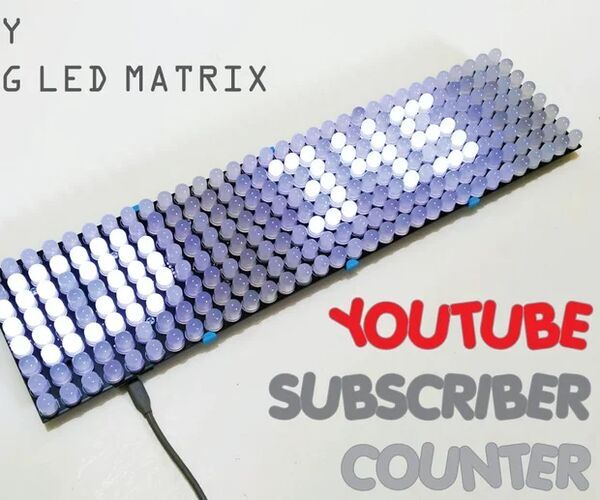
DIY BIG LED Matrix Youtube Subscriber Counter
"Have you worked with ready-made standard 8x8 LED matrix as displays to make scrolled text or to display your Youtube channel subscriber. A large readily available size is LED diameter 5mm. However, if you are looking for a much larger ready-made LED matrix, you may be out of luck. For this project, we will be building a single colour BIG LED matrix display which is made up of a few large 8x8 LED 10mm matrix modules daisy-chained together. Each of these 8x8 LED matrix modules is around 100mm x 100mm in size. This is a development from the instructables project before making ESPMatrix Devices." [...]
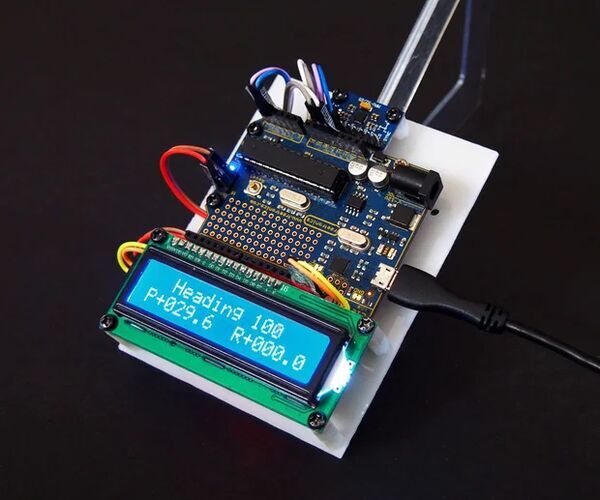
Quaternion Compass
"This instructable explains how to build, and calibrate, a tilt-stabilized compass using an Arduino UNO R3 and an MPU-9250 accelerometer | gyro | magnetometer. [1] The following options are available for displaying the compass heading | pitch | roll: Serial Monitor LCD display A graphics “compass rose” on your PC screen Calibration is simple ... three methods are provided: Tumble the compass every time at switch-on Tumble the compass once and save the results Use my “compass_cal” software and save the results A compass-heading of +/- 2 degrees is possible using my “compass_cal” software. The estimated cost for this project is $20 USD. " [...]
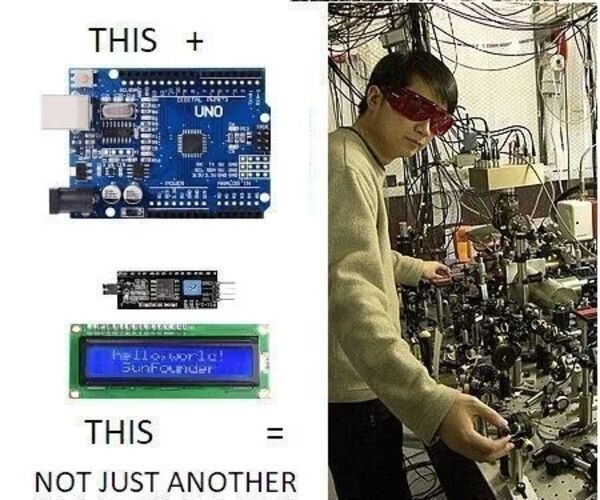
LCD DATE/CLOCK Forget the RTC
"A NIST 2010 quantum logic clock based on a single aluminum ion . In 2010 an experiment placed two aluminum-ion quantum clocks close to each other, but with the second elevated 12 in (30.5 cm) compared to the first, making the gravitational time dilation effect visible in everyday lab scales. Thus reproving Einstein's gravity theories. The clocks were reversed in positions and showed the same time offsets. NIST postdoctoral researcher James Chin-wen Chou with the worlds most precise clock, based on the vibrations of a single aluminum ion (electrically charged atom). The ion is trapped inside the metal cylinder (center right)." [...]

One-Hand 3D Printed Controller for Microcontroller Projects
"I wanted a compact and easy to use controller for all the eye mechanisms I've designed that would allow me to control them easily with one hand - including away to move the eyes, adjust how open/closed the eyelids are and blink. Since most controllers don't have a dial you can use to select a specific value (and then let go of it), this prompted me to design a controller that has a push-to-make switch and a joystick as well as a potentiometer you can use to fine-tune a value. It uses easy-to-acquire parts, but if you'd prefer to use a high-quality joystick, the design can accommodate for that too. Of course you could use this design for any application you like. This design is quite easy to make using easy to acquire parts, and the 3D printing doesn't need to be particularly good either. The hardest part is soldering, but I'd say it would be possible to build it using just jumper cables - not that I'd recommend it!" [...]
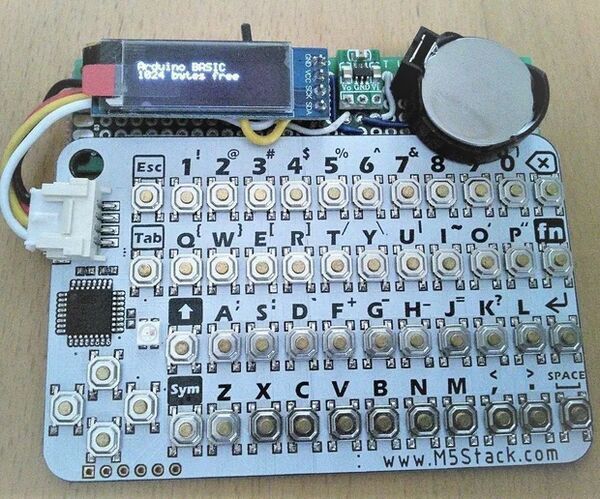
A Small and Cheap Pocket Computer That Can Be Programmed Anywhere.
"You can turn CardKB into a pocket computer!Complete pocket computer for CardKB using ArduinoBaisc, CardKB, I2C OLED screen. Since BASIC uses ArduinoBasic ( https://github.com/robinhedwards/ArduinoBASIC ), it supports almost all normal functions such as float and string variables, multidimensional arrays, FOR-NEXT, GOSUB-RETURN, etc. To do. Save and load from EEPROM is supported. The BASIC program and variables use about 1k of RAM, so it is almost equivalent to the first computer (Sinclair ZX81). The other 1k of RAM is used for the keyboard and screen buffer, and there is a little room for the CPU stack." [...]
Coffee Machine Tracker With Raspberry Pi and Google Sheets
"This instructable will show you how to build a Raspberry Pi-based tracker for the shared coffee machine in your office space. Using the tracker's OLED display and mechanical switches, the users can log their coffee consumption, see their balance and register their payments. Your system will be able to read/write data from/to a Google Sheet display user names record the coffee consumption of the users record the payments of the users show the balances of the users Supplies: (1x) Raspberry Pi Zero W (Wireless) (1x) Micro USB Cable (1x) 8GB Micro SD Memory Card (1x) 128x64 Monochrome OLED Graphic Display (1x) 2x20 Female Headers (2.54) (3x) Mechanical Keyboard Switch (3x) Keycap (1x) Custom-built PCB (You can find schematic and PCB design here. )" [...]
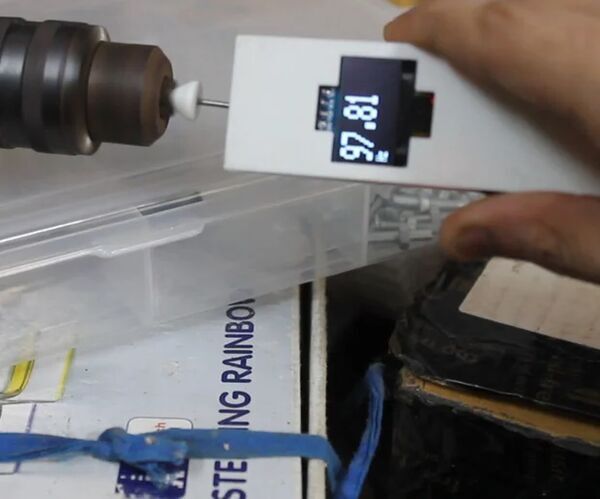
Tachometer
"Hello everyone. This time I will share my way of making a digital tachometer. It works great and can easily compete with a commercial version. On top of all, I wanted to avoid the complexity of adding a battery to the system. So I decided to make the tachometer power bank compatible. Supplies: - Arduino Pro Mini - 1306 OLED display - 3144 Hall effect sensor - Small magnets - micro USB hub - wires, solder etc." [...]
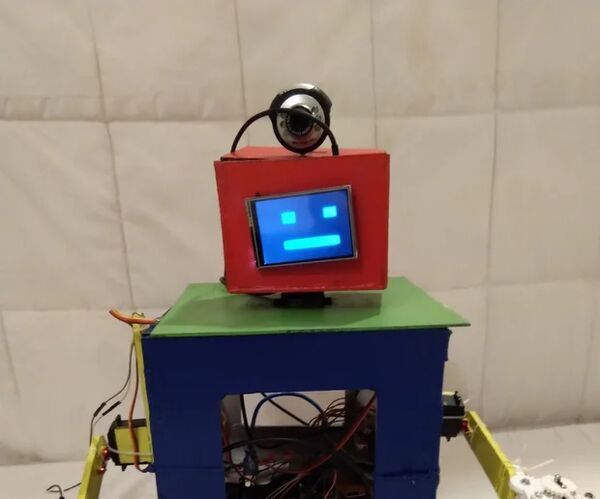
Cypherbot (an Assistant Robot)
"Cyphersoft is an assistant robot that can be your friend and help you while you work. It can talk and walk. You can customize and use it for anything you can imagine. Now you can make an intelligent robot with just an Arduino and Raspberry Pi.If you have any suggestions to improve this robot then please suggest in comments Supplies: 1.Raspberry Pi (any model will work except zero) 2.L293D IC or L293D Motor driver shield 3.USB Mic 4.Raspberry Pi TFT Screen(3.5 inch) 5.MDF Board or Cardboard 6. Servo motors (x6) 7. B.O." [...]

1984 WeatherMan Pi
"This portable cassette player is now an ambient IoT weather display with early 80s style, displaying a "current conditions" animation, scrolling temperature and rain probability graph through the tape window. When the weather condition changes the servo-controlled headphones on top jiggle back & forth as a subtle alert. Opening the functional tape door we can see that the dusty original components have been replaced with a Raspberry Pi Zero W, a Pimoroni Unicorn Hat HD (LED Matrix) and a small servo. The weather data is sourced using a Python script that queries the ultra-accurate Dark Sky Weather API, tailored to my specific location. It's a simple but lovely-looking and functional IoT build that sits on the opposite desk speaker to my YouTube counter, quietly keeping me up to date with the weather. Supplies: - Raspberry Pi Zero - Pimoroni Unicorn HAT HD - Small Servo - 1984 Hitachi SP-1 Personal Stereo & Headphones - USB WiFi Adaptor - 2mm Threaded Rod - Sugru (Black & Grey) - GeoMag magnet" [...]

DIMP 2 (Desulfator in My Pocket 2)
"Mikey Sklar designed the DA PIMP 2 ("Power In My Pocket 2") based on George Wiseman's paper "Capacitive Battery Charger" and generously released it to the open hardware community back in 2014. It is capable of charging and desulfating/rejuvenating just about any rechargeable battery of any type, so long as the battery is not totally unrecoverable. For more info on Mikey's DA PIMP 2: mikeysklar.blogspot.com/p/da-pimp-battery-desulfator.html After eagerly waiting for Mikey to release DA PIMP 3 for a long while, I decided to design my own with a focus on safety and voltmeter accuracy and call it DIMP ("Desulfator In My Pocket") version 1. However, after communicating with some fans of DA PIMP 2, it seems that there is a preference for the all-in-one desulfator + voltmeter design of DA PIMP 1 and 2, so I have designed DIMP version 2 with an integrated voltmeter. Here are the differences between Mikey's DA PIMP 2 and my DIMP 2: Switched to four-digit LED display Rewrote voltmeter code on ATMEGA48V-10PU for four-digit display and improved accuracy at the low end Replaced rare Schurter rocker switch with commonplace OMRON A8L rocker switch Replaced dangerous jumper headers (used to select current output) with C&K L202 slider switches Increased max power rating for R1 resistor Changed diode bridge from round to D3K rectangular package Reduced fuse cartridge size to 5mm x 15mm 2AG Reduced PCB width to 61mm to fit soap box case Increased PCB length to 97mm to fit the slider switches and extra display resistor Moved 9V battery so that it will fit better vertically under the soap box's domed lid Added J5 and J6 strain relief holes for 9V battery leads Added PCB mounting holes (J4 at top left is at 12.5mm,17.5mm from top left corner, J7 at bottom right is at -4.0mm,-4.0mm from bottom right corner) for 3D-printed housings with screw bosses DIMP 2 is sold on ebay as a PCB and pre-programmed ATMEGA48V-10PU for DIY assembly. If you can solder with a low wattage pencil iron, you can assemble the DIMP 2." [...]

IoT-Terrarium
"My girlfriend is obsessed with house plants, and a little while ago mentioned she wanted to build a terrarium. Keen on doing the best job she googled how to's and best practices of how to create and look after one of these. Turns out there is a million blog posts and no one straight answer, and it all seems to come down to the look and feel of how individual terrariums are growing. Since I am a man of science and I like data to know if something is actually working, I wanted to put my knowledge of IoT and electronics to good use and create an IoT Terrarium monitor. The plan was to build a sensor based system that could monitor temperature, humidity, and soil moisture from a simple yet elegant web page. This would allow us to monitor the terrarium's health so we always knew that it was in the best condition." [...]
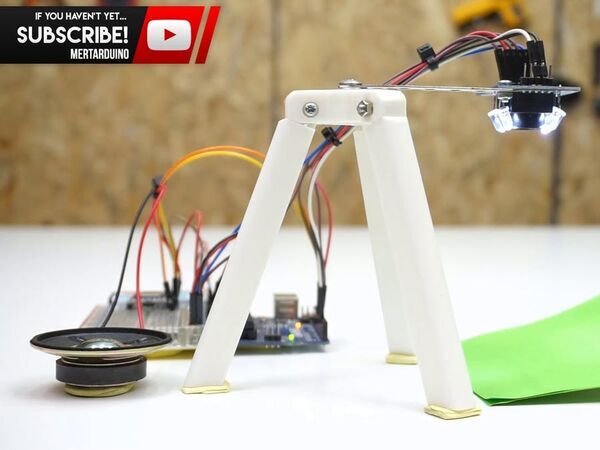
Talking Color Detect System | Arduino | DFPlayer | GY-31 TCS
"Arduino will detect colors with the GY-31 TCS3200 color sensor and the detected colors will be voiced by the DFPlayer module. In this project, I will show you How to Make Talking Color Detect System. Arduino will detect colors with the GY-31 TCS3200 color sensor and the detected colors will be voiced by the DFPlayer module. " [...]
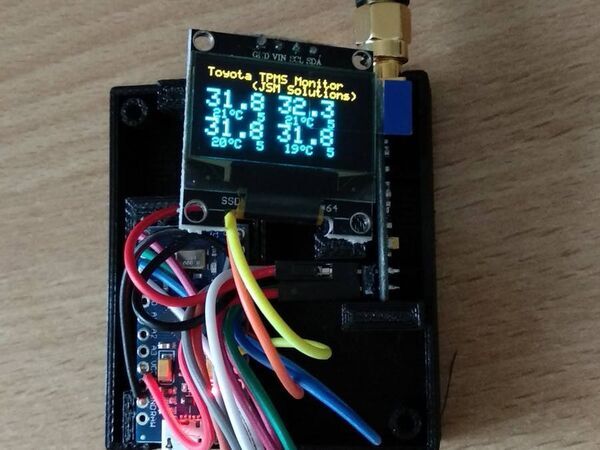
Arduino Renault TPMS Tyre Pressure Display
"Project using Arduino Micro and CC1101 to display the tyre pressures transmitted at 433MHz by Renault tyres (based on Toyota TPMS project). This is an enhancement from a similar project of mine for Toyota TPMS found here on Hackster.io. Please see that project for the full explanation, the hardware and circuit diagrams (which are unchanged for this project). The only change is in the software which is documented here. This was done in collaboration with Banni (thank you) as I did not have a Renault TPMS tyre at the time. Once again, thanks go to the RTL_433 team for their invaluable work on the protocol decoding for SDR." [...]
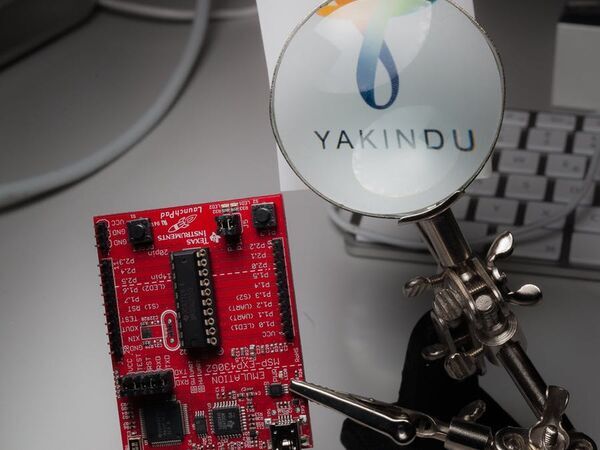
Finite State Machine on a MSP430
"How to program a MSP430G2 Launchpad with Finite State Machines (FSM) using YAKINDU Statechart Tools in your Code Composer Studio. This tutorial contains six steps: - Installing YAKINDU Statechart Tools as a plugin to Code Composer Studio - Getting started with State Machines in Code Composer Studio - Create the Blinky State Machine - Generate the State Machine C code - Calling the State Machine from your code - Run the project! This project can be used as a blueprint for any MPS430 or MSP432! " [...]
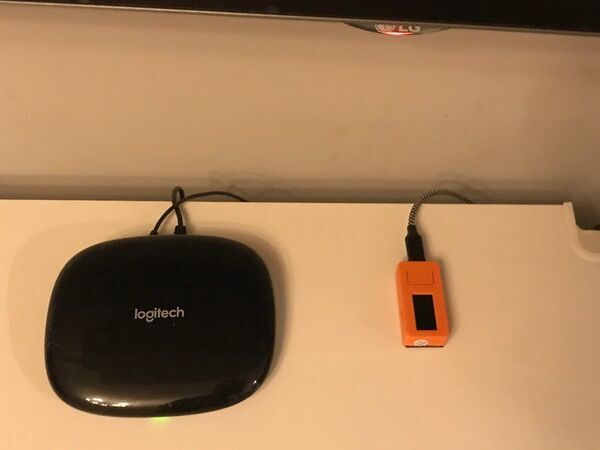
Turn M5StickC Into Universal IR Remote (Home Automation)
"Take a $9 M5StickC, few lines of YAML configuration to build ESPHome, Home Assistant and start controlling your TVs and climates in minutes. In this project I document how I changed my Home Assistant setup replacing the Logitech Harmony Hub ($60) for a cheaper, smaller, and more versatile M5StickC ($9) with just ESPHome onboard and a few lines of YAML configuration. The ingredients are: A running Home Assistant instance (mine is hass.io on a RPi4) The SmartIR custom component An MQTT broker (mine is the mosquitto hassio addon) An M5StickC The configuration/source files of this project. Due to the great ability of the ESPHome lib/firmware for templatable actions, I was able to setup the remote_transmitter component to translate generic JSON inputs into IR codes to transmit with just 16 lines of ESPHome YAML config. So I built a firmware that acts as an MQTT->IR bridge, and that can run on a M5StickC (or a M5CameraF + grove IR transmitter), making it fully integrated with the smartir custom component of Home Assistant. In this way I can set up several "media_player" or "climate" entities, with just the list of codes they support as commands." [...]
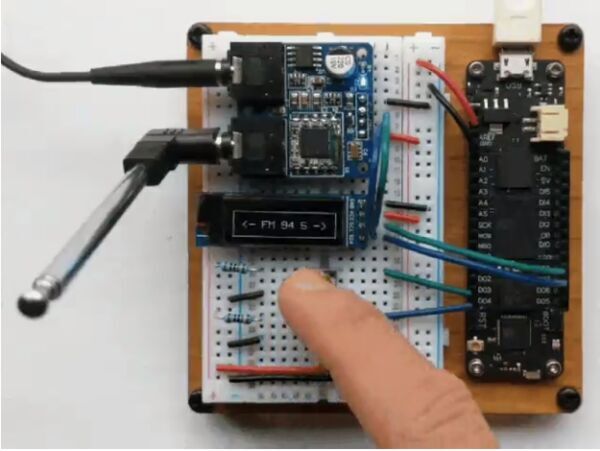
Build an FM Radio Player with Meadow
"Learn how to make an FM radio with a TEA5767 radio module, push buttons and a I2C OLED display, all using Meadow. Foundation. Lets build a full functioning FM radio player using a TEA5767 FM radio module, and an intuitive UI using push buttons to change stations and an OLED display to see the station you're listening to. Most of the components needed to build this project is included in the Wilderness Labs Meadow F7 w/Hack Kit Pro. Both the radio module and the display uses an I2C bus protocol that helps you connect these peripherals with only 2 pins on the Meadow board. You can read more about I2C here." [...]
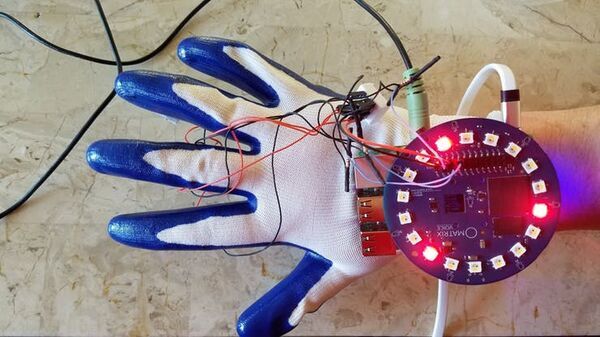
GloMusic
"Voice select music instrument interface. Easy to access a wide variety of music instruments. Innovation on music instrumentts as an educational and creative tool has being a subject of research in the last couple of years. Having two members of our team being students from a high school with a strong musical curriculum we come up with this new instrument. We present a new take on music interaction where a single interface (glove) can control different instruments at a time. The Matrix Voice ESP32 give us the chance to break the process in two different tasks: The collection of data using external sensors (pressure) and the voice command recognition with SNIPS, instrument management and play." [...]

Bluefruit Luminary Lanterns with Capacitive Touch
"Design beautiful customizable luminary lanterns for your home or garden. Cut them out on a vinyl cutter or laser cutter, and fill them with light using a Circuit Playground Bluefruit Express and Adafruit's NeoPixel rings. Add custom color animations and control the lanterns with Adafruit's BlueFruit app. We've also added capacitive touch control, so you can change color modes just by touching the lantern. Circuit Playground Express has all this functionality already built-in, so it's easier than ever to create gorgeous controllable lights. If you're making just one lantern, this project doesn't require any soldering at all!" [...]

Open Source Powered Prosthetic Leg
"With an ever-increasing availability of new technologies, we created an affordable bionic leg that is accessible to everyone. An accessible powered prosthetic -- open-source and affordable. Simple, effective, assistive tech developed to accommodate continuous development. Brought to you by a bunch of hardworking undergraduates enamored with a vision of a future where robotics is widely used to improve the quality of life for all. While new technology endeavors are often profligate, our leg costs about as much as a mid-tier IKEA couch ($550). Our project and price point rely strongly on the utilization of new tech, such as continuous 3D printed carbon fiber, that has only recently become available." [...]

IoT Nixie Clock Shield for Arduino
"IoT Nixie Clock can be controlled via Arduino Cloud or Amazon Alexa thanks to the Arduino Nano 33 IoT. Use your Arduino and build IoT Nixie Clock, Thermometer and Hygrometer. Nixie Clock Shield is designed for all Arduino boards (Uno, Micro, Nano), but works best with the new board Arduino Nano 33 IoT. Arduino Nano 33 IoT is fully compatible with the Arduino IoT Cloud. You can control the shield via the cloud, you can send data to the cloud then transfer it to e.g. Google Sheets and visualize (e.g." [...]

Introduction to Bare Metal Programming in Arduino Uno
"A short tutorial to start programming Arduino Uno without using the Arduino IDE. Introduction In this tutorial, we are going to see how to program the Arduino Uno without using the Arduino IDE. We will see how the Arduino IDE works under the hood. How Arduino IDE works The Arduino IDE uses the avr-gcc compiler and avrdude to upload our program in the microcontroller. So, we are going to compile using avr-gcc the source code (written in C) to obtain the corresponding object file. Then through avr-gcc, we link the system libraries to the object file to produce the executable or the ELF file." [...]
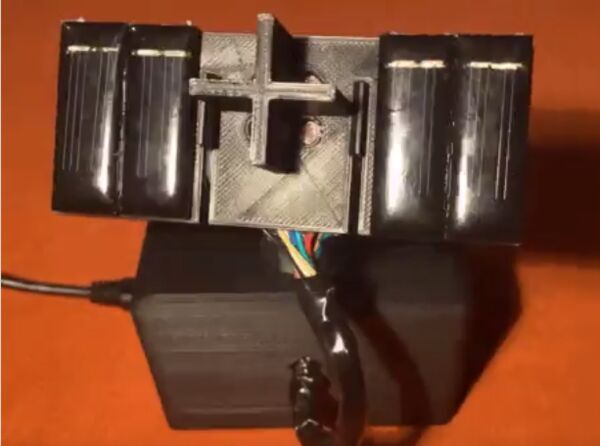
Solar Energy in the Cloud
"You'd think that solar energy and clouds are not the best match, but in this project I'll show you how you can make it work! The future is here, solar panels everywhere! In the last couple of years a lot of photovoltaic power station have been built, but usually they are using fix placement and thus the solar panels rarely receive the light in the optimal, 90 degree angle. I wanted to do some experiments on how I can create an inexpensive solar tracker solar panel while I can remotely control and monitor the results. Another issue I'd like to handle is the negative energy price at peak production hours. It is just as big of an issue as the lack of power as overproduction can damage the electrical network and its connected devices." [...]

Mood-a-tron 3000
"The project is an example of how to not only obtain telemetry data with an MT3620 based Azure Sphere device, but also how to consume and visualize the data in an extremely secure manner. The project will track the mood of the office and report it to the cloud for further analysis. The project will have the following features: - Interesting form factor so that a passer by would take notice of the device. - An array of buttons with which a person could indicate their mood. - Good: Press the Green button. - Average: Press the Yellow button." [...]
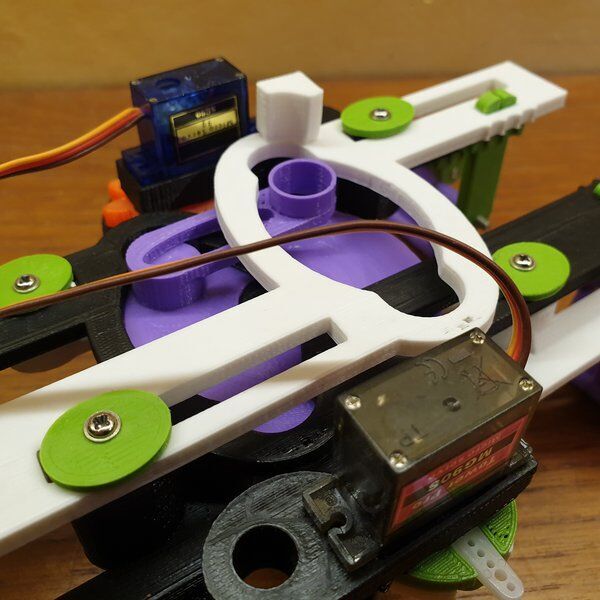
Landbeest walking robot
"Terrain-going quadruped. 3D printable. Two servo drive. I'm designing a 3D printable quadruped which only uses two servo motors. One servo for moving forward and the other one for steering. Want it to be easy to build and control." [...]
That's all Folks!



